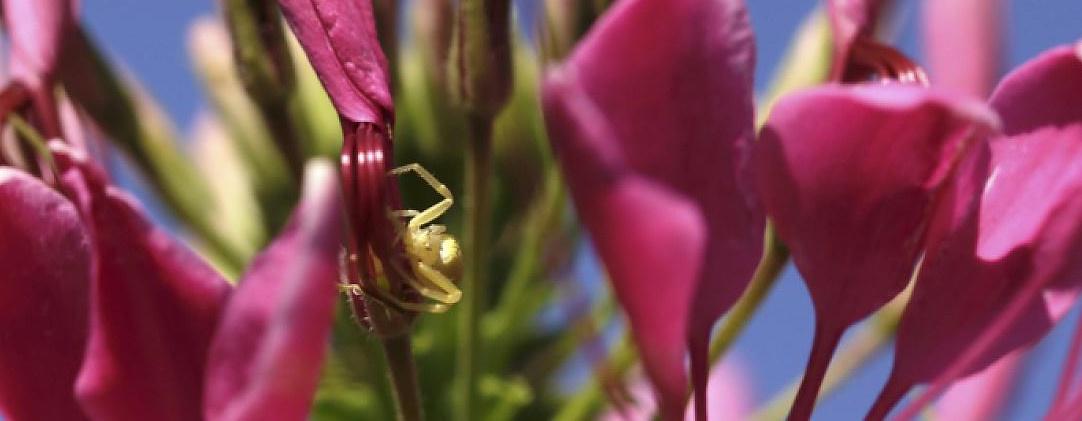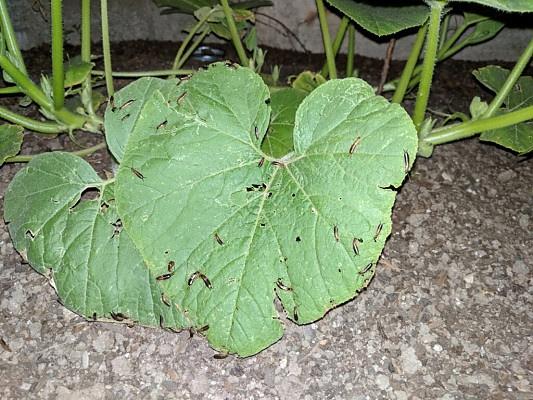You can find a list of flowers that have natural pesticide properties and the pest insects they affect on this webpage.
Diversifying your garden by adding a variety of flowers not only attracts natural enemies but can also interfere with visual or olfactory orientation of pests to their host plants. IPM requires a bit of research and a little extra planting. But the result is having a more diverse garden, more flowers, fewer pests, and all while picking up some solid garden knowledge to impress your neighbors with. We’ve included some helpful resources like the Utah Pests Newsletter you can subscribe to for free! This quarterly newsletter is full of helpful tips, pest identification, techniques, and other resources.
- Nurse Cropping - The practice of using plants that will protect your plants (so cute) in a symbiotic relationship. Some examples are plants that provide shade, a wind guard, or a dust barrier to other plants.
A great example is that of Peterson Family Farms’ head farmer, Luke, planting a wall of sunflowers to protect his cash crop from dust. Not only are the sunflowers attracting beneficial predators and pollinators, like birds and bees, that will feed on pests but they also help to trap the dust being kicked up by heavy traffic from the adjacent dirt road. The sunflowers help to keep the dust off the field of crops while also discouraging dust mites, a pest that loves hot and dusty environments.
If you’re growing taller crops like corn or beans, you can plant any number of cucurbits beneath them. The large broad leaves of the cucurbit (like squash or pumpkin) restrict sun exposure to the underlying soil which can suppress weed growth.
- Trap Cropping - Trap crops are sacrificial crops that attract pests away from more desirable garden plants.
This companion planting method is most often used by experienced farmers with a large field area of crops but you can also try this technique in your backyard garden.
A great example is that of Blue Carpet Petunias. Thrips, a microscopic insect pest, can prey on tomatoes and other vegetable plants, however, thrips are highly attracted to the petunias, which can lure the insect away from tomatoes and peas. If you find you have a thrip problem, you can plant the petunias next to tomatoes or peas and once the thrips have taken over the petunias you can pull them to reduce the local pest pressure and throw them away.
Trap cropping can be tricky and requires a vigilant eye on the garden. You want to make sure the trap crop is more attractive to the pest than your desired vegetable and you’ll want to monitor the trap crop closely to ensure that the pests don’t overpopulate and move to your desired crop. This write-up by ATTRA has more information on trap cropping.
- Nitrogen Fixating and cover cropping - Two planting techniques that build healthy soil.
Having good soil is the foundation for any healthy garden. Good soil cannot be underestimated and is something every gardener or farmer needs to care for each season.
The roots of legumes like peas, beans, and clover, add nitrogen to the soil quality which is very helpful for heavy nitrogen feeders like corn, tomatoes, or cabbage. When the time comes to winterize your garden at the end of the season, planting a cover crop will not only help protect your soil over the long winter months but will also add nutrients for a better growing season the following year.
There are a number of different cover crops you can use. This page from the USU extension offers helpful information and excellent tips on cover crops.
“Cover cropping is a great tool for home gardens because the crops serve as a ‘green manure’ which can help build soil fertility, improve soil structure and improve soil quality over time. It’s good for home gardeners to utilize cover cropping more often because it can also act as a green manure, so it can help to add soil fertility, increase soil structure in the root zone of the plants so it benefits the plants over time."
- Katie Wagner
In the spring when you start to prepare your garden or planting boxes, you can pull up the cover crop, chop or tear it into smaller pieces, and turn it over back into your soil. This method is sometimes referred to as adding “green manure” into your soil. Do this before the cover crop has gone to seed so you’re not battling cover crop growth all season.
A classic example of a well-balanced companion planting set-up is a traditional Native American technique called the Three Sisters. A Three Sisters garden is composed of corn, beans, and squash. The corn provides the poles for the beans to grow up, while the beans add nitrogen back to the soil. The squash grows below providing shade.
- Farmscaping - A gardening approach to managing biodiversity within the garden with the goal of increasing the presence of beneficial organisms.
In a sense, all of the above can fall under the larger umbrella term of farmscaping.
Farmscaping elements attract and retain beneficial insect populations to garden or farm areas. That said, farmscape plantings will also provide additional benefits to garden ecosystems but the emphasis is on natural enemies, not soil fertility or weed suppression.
The nectar from flowers is a source of liquid sugar, energy, and vitamins for beneficial insects or natural enemies, and is critical for their optimum performance of hunting and eating pest insects.
In farmscaping, beneficial organisms are managed much like “mini-livestock.” The gardener makes sure there are ample flowers to sustain and increase the natural enemy populations by providing a habitat and hunting grounds garden home for them their populations to expand.
However, creating a farmscape of flowering plants picked at random may favor pest populations over beneficial organisms, so you want to do your research and prepare your garden plans before the start of the season. This article is a good guide for planning a farmscape.
Companion planting can offer helpful techniques to manage those nasty pests in your garden; however, as mentioned in the videos, it’s not the silver bullet. As much as we loath pests, we’ll never completely eradicate them from the garden. Practicing some of the techniques listed here can benefit your garden and Utah’s native bees who come to live there tremendously.
If you live in Utah and have a garden or garden project that you'd like to be featured on Modern Gardener, click here!




